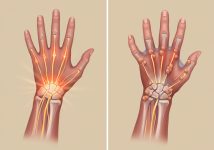
Carpal Tunnel Syndrome and Dupuytren’s: Overlapping Hand Conditions Explained
Carpal Tunnel Syndrome and Dupuytren’s: Overlapping Hand Conditions Explained
Introduction
Hand pain, stiffness, and difficulty gripping are common complaints. But not every hand problem is caused by the same condition. Two of the most common are carpal tunnel syndrome (CTS) and Dupuytren’s contracture. While they affect the hand differently, they often appear in the same patients, sometimes even complicating diagnosis. Understanding both conditions helps patients and doctors create effective treatment plans.
What is Carpal Tunnel Syndrome?
Carpal tunnel syndrome occurs when the median nerve is compressed as it passes through the wrist. This leads to:
- Numbness and tingling in the thumb, index, and middle fingers.
- Weakness in hand grip.
- Nighttime symptoms that wake patients.
It results from inflammation, repetitive wrist motion, thyroid disease, or diabetes.
What is Dupuytren’s Contracture?
Dupuytren’s contracture, by contrast, involves thickened cords in the palm. Instead of nerve pain, it causes fingers—often the ring and little finger—to bend toward the palm. The difference: CTS affects sensation, while Dupuytren’s affects motion.
When Both Conditions Overlap
It’s not rare for patients to have both conditions simultaneously. Fibrosis in Dupuytren’s and tissue swelling in CTS share common biological pathways, including collagen changes and inflammation. In fact, some studies show that Dupuytren’s patients are more likely to be diagnosed with CTS.
Diagnosis
- CTS: confirmed by nerve conduction tests or EMG.
- Dupuytren’s: diagnosed with a simple hand exam (tabletop test).
When both coexist, doctors must carefully determine which symptoms stem from nerves versus tissue cords.
Treatment Options
- Carpal Tunnel: splints, steroid injections, and surgery (carpal tunnel release).
- Dupuytren’s: observation, needle aponeurotomy, collagenase injection, or fasciectomy.
Patients with both conditions may undergo staged treatment—addressing nerve compression first, then fibrosis.
What the Science Says
Medical literature shows a statistically significant overlap between Dupuytren’s and CTS. Researchers propose shared inflammatory and metabolic risk factors, including diabetes, alcohol use, and thyroid disease. This makes awareness critical: ignoring one condition may prevent full hand recovery.
Connections to Dupuytren’s
If you have Dupuytren’s and experience numbness or tingling, don’t assume it’s part of the disease. It could be carpal tunnel syndrome as well. Treating both conditions is often necessary to restore full hand function. Discuss wrist symptoms with your provider, especially if Dupuytren’s treatment hasn’t resolved hand discomfort.
Key Takeaways
- Different mechanisms: CTS compresses a nerve; Dupuytren’s stiffens tissue.
- Overlap common: Patients may have both at once.
- Diagnosis matters: Tests distinguish nerve vs. fibrosis issues.
- Treatment sequencing: Sometimes both need staged care.
- Awareness helps: Addressing both improves long-term outcomes.
Attribution
Attribution (CC BY 4.0): Adapted from Becker SJ, Davis TRC. Carpal Tunnel Syndrome and Dupuytren’s Disease: An Overlapping Problem. Plast Reconstr Surg. 2017;139(2):290e-301e. Licensed under Creative Commons Attribution 4.0.
For the complete article and reference list, click Source.
Call to Action
Call to Action: Join our Dupuytren’s community for patient stories, therapy tips, and ongoing research: https://www.facebook.com/groups/dupuytrensolutionsandhealth. Explore every treatment pathway at https://www.dupuytrensolutions.com.






